How to maintain the battery in this season is good?
After a long summer, although the temperature is still high during the day, the dry autumn is slowly coming. In the fall, car batteries are relatively prone to problems. Since the battery is the main power supply system on the car, if the battery is not working properly, you will be on the road someday, so it is especially important to pay attention to the daily maintenance of the battery. Proper use of the battery not only extends the life of the battery, but also makes your car more smooth.

The main power of the onboard system comes from the battery
Inspection articles
Routine routine inspection
The battery is usually in the engine compartment. There are some protective covers on the outside. Although the outside world will not have a direct impact on it, if the battery ages, there will be overheating inside. The change of heat and cold will lead to the original flatness. The surface is deformed. If you notice that the shape of the battery has changed, you must replace it.
In addition to checking the battery in appearance, the owners can also perform self-tests through color changes in the circular inspection windows on some maintenance-free batteries. In addition, some professional tools are required to check the batteries. Other more professional tests should be carried out by professional repair shops to avoid danger.
In general, the battery life cycle is about 2 years, but if the owner uses the proper life, it can reach 4-5 years.
Reminder: After 2 years of general use, it is necessary to carry out relevant inspections.
Voltage check
The battery standard voltage in good condition should be kept between 12.2-12.7V. If the voltage is too low, it should be charged. When charging, keep a small amount of charge for a long time. Charging the battery requires a professional charger. The owner must not try to charge it himself. The owner can charge the battery as long as the engine is running. If the battery ages, it should be replaced.
Reminder: If the battery is not damaged, normal startup operation can generate electricity and charge.
Electrolyte density check
This is an important parameter for evaluating whether the battery is charged properly or not, and can be measured by a densitometer or an electrolyte density tester. If the electrolyte density is too small, charging is required. If the electrolyte concentration is too rich or too thin to a certain extent, it means that such as plate vulcanization, short circuit or overcharge occurs, and maintenance is required at this time.
Reminder: This inspection generally requires the professional technician of the repair shop to check, and the owner does not usually have the corresponding tools.
Check battery pile head
The battery pile head is the part where the battery is connected to the vehicle. If corrosion or poor connection occurs, the battery will work poorly. The owner can check whether there is white powder near the pile head. These are the signs of corrosion of the pile head. If the white powder is more or there is green oxide, it can be boiled off with boiling water, then anti-corrosion treatment, apply some grease or preservative on the pile head, but be careful not to apply too much. So as not to affect the use.
Reminder: This check must be worn with gloves to avoid corrosion of your fingers.
Note
Use battery 3
1. Do not block non-maintenance battery vents. The vents of non-maintenance batteries are used to dissipate heat and release internal pressure. If the vents are blocked, the internal pressure will rise and the battery will explode if it is severe.
2. Do not use incorrect charging methods. The battery should be charged for a long time with a small current. If a large current is used for a long time, the electrolyte will boil and the internal water will evaporate, which will change the density of the electrolyte.
3. Do not work under long-term loss of power. If the owner of the vehicle inadvertently causes excessive battery discharge, after restarting the vehicle, at least the engine should be operated for 1 hour to charge the battery. If you have the conditions, you should drive, even if you are under idle conditions, you can charge the battery. If you want to improve the charging effect, you can increase the engine speed. Generally, you can get a good charging effect at 1200 rpm. Occasionally, the battery over-discharge condition occurs once or twice, which has little effect on the life of the battery. As long as the owner solves the problem, the battery is fully charged. Long-term operation in the deficient state has the greatest damage to battery life.
The Filter Element consists of randomly arranged stainless steel metal fibers with uniform and fine micro holes.
Available pressure stability:
W/HC:210 bar
Size
0030, 0060, 0110, 0140, 0160, 0240, 0280, 0330, 0500, 0660, 0990, 1320, 1500.
Filtration rating:
V:003, 005, 010, 020 µm
COMPATIBILITY WITH HYDRAULIC FLUIDS ISO 2943
Hydraulic oils H to HLPD DIN 51524
Lubrication oils DIN 51517, API, ACEA, DIN 51515, ISO 6743
Compressor oils DIN 51506
Biodegradable operating fluids VDMA 24568 HETG, HEES, HEPG
Fire-resistant fluids HFA, HFB, HFC and HFD
Oil Filter Element,Line Filter Element,Stainless Steel Filter Element,V/Hc Filter Element
Xinxiang Shengda Filtration Technique Co., Ltd. , http://www.shengdafiltration.com